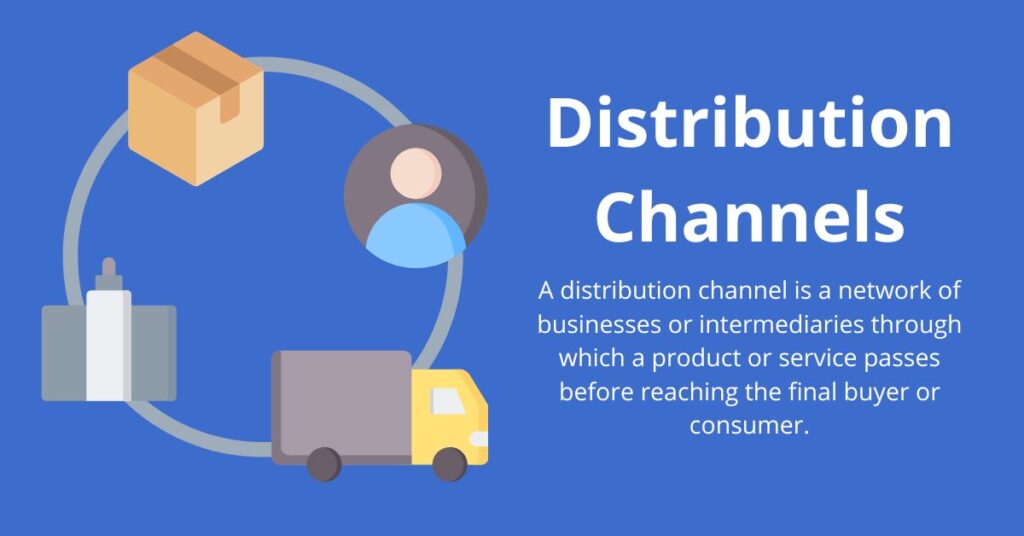When running a business, getting your products or services to your customers is a top priority, and how efficiently you handle this aspect can make or break your business. Distribution channels are the lifelines that connect your offerings to consumers. Understanding these pathways is vital for ensuring your products reach the right hands at the right time.
What is a Distribution Channel?

A distribution channel is a series of businesses or middlemen that a product or service goes through before it gets to the end customer. This system can include wholesalers, retailers, distributors, and online platforms.
These channels are essential for the downstream process, which focuses on delivering products to consumers. This contrasts with the upstream process, or supply chain, which concentrates on sourcing and managing suppliers.
Types of Distribution Channels
Below are the various types of distribution channels to enhance your market penetration.
Direct Channels
Direct channels involve selling your product straight to the customer without any middlemen. Examples include:
- Company Websites: Selling directly through your online store allows you to manage the entire sales process and build a direct relationship with your customers. This can include providing detailed product information, personalized marketing, and direct customer support.
- Physical Stores: Operating your retail store gives you control over the customer experience from the moment they enter your store to the point of sale. You can create a brand-specific shopping environment and offer in-person customer service.
- Direct Mail: Sending product catalogs or promotional materials directly to consumers’ homes can target specific audiences and encourage direct purchases through phone or online orders.
- Social Media Promotion: Leveraging platforms like Instagram and Facebook is a smart way to sell products directly to consumers through shoppable posts and integrated e-commerce features.
Indirect Channels
Indirect channels use intermediaries like wholesalers, retailers, and distributors to get your product to the customer. Examples include:
- Wholesalers: Wholesalers purchase large quantities of products from manufacturers and sell them in smaller quantities to retailers. This helps manufacturers reach a broader market without managing numerous individual retailer relationships.
- Retailers: Stores like Walmart or Target sell products directly to consumers. Retailers often have established customer bases and extensive market reach, making them valuable partners for manufacturers.
- Distributors: Distributors help place products in various retail locations, manage logistics, and handle the transportation and storage of goods. They often have specialized knowledge of certain markets, which can be beneficial for targeting specific demographics.
Hybrid Channels
Some businesses use a mix of both direct and indirect channels to reach their customers. For instance:
- A company might sell products on its website while distributing them through third-party retailers. This approach allows businesses to reach different customer segments and increase market coverage.
- Hybrid channels can also include partnerships with other companies to co-brand products or offer exclusive deals through specific retailers. Developing cross-promotional campaigns with complementary brands can help to expand your reach and offer added value to customers.
- Pop-up shops or temporary retail locations can combine the benefits of direct selling with the flexibility of temporary setups, allowing brands to test new markets or product lines.
Choosing the Right Distribution Channel
Selecting the right distribution channel depends on several factors:
- Product Type: Perishable goods, like fresh produce, require fast, direct channels to maintain quality, while durable goods, such as electronics, can be distributed through more extended, more complex channels. Cold chain logistics should be considered for perishables and specialized handling of fragile items.
- Market Reach: For businesses targeting a large, geographically dispersed market, intermediaries like wholesalers and distributors can extend their reach more effectively than direct channels alone.
- Company Resources: Establishing and maintaining direct channels can be resource-intensive. Smaller companies might benefit from partnering with intermediaries with the necessary infrastructure.
- Customer Preferences: Understanding where and how your customers prefer to shop is crucial. For example, investing in a robust e-commerce platform is essential if your target audience prefers online shopping.
- Competition: Analyzing your competitors’ distribution strategies and identifying opportunities to differentiate your approach or fill gaps in the market is a vital move to factor into your distribution channel.
Examples of Distribution Channels in Action
These are real-world examples of distribution channels in action to inspire your strategy.
Coca-Cola
Coca-Cola uses a massive and complex network of bottling partners and distributors to reach over 200 countries. This approach allows them to sell 2.2 billion servings of their beverages daily through various intermediaries, ensuring global availability and convenience for consumers. Their distribution system includes local bottlers who manage production, packaging, and delivery to retail outlets, ensuring that products are always fresh and available.
Natura
Natura, a cosmetics brand, distributes its products using a combination of business-to-business (B2B), e-commerce, and franchising. This multi-channel approach helps Natura reach millions of customers in over 100 countries. It leverages online sales, physical stores, and independent consultants to maximize its market presence and offer customers various purchasing options.
Distribution Channel Levels
Below are the various levels of distribution channels to optimize your product flow.
Level 0
In a direct-to-consumer model, the producer sells its products straight to the end consumer without intermediaries. Amazon exemplifies this by using its platform to sell Kindles directly to customers. This is the shortest possible distribution channel, eliminating the need for wholesalers and retailers.
Level 1
At this level, the producer sells to a retailer, who then sells the product to the end consumer, involving only one intermediary. Companies like HP and Dell follow this model, selling their computer products directly to reputable retailers such as Best Buy.
Level 2
This level includes two intermediaries: a wholesaler and a retailer. It is one of the more extended distribution channels. For example, wineries cannot sell directly to wine and adult beverage retailers. They must first sell to a wholesaler, who then sells to a retailer, and finally, the retailer sells to the end consumer. This multi-tiered system is often mandated by law.
Level 3
At this level, an additional intermediary, such as a jobber, is included. Jobbers purchase products from various producers, store them, and then sell them to retailers. They act as intermediaries between wholesalers and retailers, further extending the distribution channel.
Benefits of Effective Distribution Channels
Below are the key benefits of effective distribution channels to enhance your operational efficiency.
Increased Market Reach
Effective distribution channels significantly expand your product’s availability, exposing your offerings to a broader audience. By strategically leveraging diverse channels, businesses can tap into new markets and customer segments, dramatically increasing their reach.
This expansion often requires tailoring your approach to different regions and cultures. Implement localization strategies that go beyond mere translation, adapting your products, packaging, and marketing messages to resonate with local preferences and customs. This might involve modifying product features, adjusting pricing strategies, or creating region-specific marketing campaigns.
Enhanced Customer Satisfaction
Efficient distribution channels are the backbone of superior customer service, facilitating quicker delivery times and enhancing overall customer satisfaction. When customers receive their products promptly and have access to reliable support, they’re more likely to become repeat buyers and brand advocates.
To optimize this process, implement real-time tracking systems that provide visibility into every stage of the delivery journey. Complement this with proactive communication strategies, keeping customers informed about their order status through automated notifications. This transparency not only reduces customer anxiety but also minimizes support inquiries.
Cost Efficiency
Well-chosen channels can significantly reduce logistics and storage costs. By strategically using intermediaries, businesses can minimize the need for extensive warehousing and transportation infrastructure.
This approach not only lowers overall operational expenses but also allows for greater flexibility in scaling operations. To maintain optimal efficiency, it’s crucial to regularly analyze channel performance, identifying and eliminating any inefficiencies that may arise.

We empower people to succeed through information and essential services. Do you need help with something? Contact Us.
Want a heads-up once a week whenever a new article drops?







